Free Downloads
Handouts, Articles and Resources
Handouts
Phase Four: When to stay out of the way and when to guide reprocessing

-
Summary
EMDR trained clinicians are taught to stay out of the way and allow the patient’s brain to guide the process. Yet spontaneous reprocessing can become unproductive or even disruptive to patient stability.
Clinicians can remain overly passive or become overly active redirecting patients too frequently back to target or offering randomly selected interventions.
Participants will be invited to discuss transcripts of EMDR reprocessing sessions that illustrate both skillful interventions and common clinical errors. Transcripts will present key choice points, varieties of interweaves, ways of addressing dysregulated states and advanced interventions such as targeting dissociative phobias and avoidance defenses. -
Download
This free PDF provides the complete 2018 handout for session 232 of the EMDRIA Conference, presented October 5, 2018, in Atlanta, GA by Andrew M. Leeds, Ph.D.
To download without cost just enter 0 in the price field. Or if you wish, put down any number from 1 or more.

-
Summary
In the EMDR approach to psychotherapy, each patient is approached in an individualized manner. This presentation will clarify core elements of history taking and AIP informed case formulation including pacing, methods and depth of history taking and simple ways to screen for factors that complicate EMDR therapy. Participants will consider best practices for responding to Phase one case vignettes including: pacing history taking, prior adverse EMDR therapy experiences, and fears of facing a traumatic past. Forms for organizing patient history, triggers, symptoms and concerns will be presented and reviewed. Sample target sequences will be presented for common treatment plans.
-
Download
This free PDF provides the complete 2017 handout for session 333 of the EMDRIA Conference, presented August 26, 2017 in Bellevue, WA by Andrew M. Leeds, PhD.
To download without cost just enter 0 in the price field. Or if you wish, put down any number from 1 or more.
Mechanisms of Action in EMDR Therapy: Multiplex Effects of Bilateral Stimulation

-
Summary
After 25 years of research on EMDR therapy’s mechanisms, we cannot provide an evidence based explanation for all its treatment effects. Before examining mechanisms, we must first consider differences between mediators, mechanisms and moderators of change in general psychotherapy (Kazdan, 2007) and in EMDR therapy.
An analysis of the literature generates six distinct hypothesized mechanisms of action that provide diverse multiplex effects, sometimes converging and sometimes diverging, leading to various outcomes in different clinical contexts and in different EMDR procedures.
Implications for EMDR therapy include moderators such as degree of structural dissociation and mediators including modes of bilateral stimulation. -
Download
This free PDF provides the complete 2015 handout for session 222 of the EMDRIA Conference, presented August 26, 2016 in Minneapolis, MN by Andrew M. Leeds, PhD.
To download without cost just enter 0 in the price field. Or if you wish, put down any number from 1 or more.
Learning to Feel Good Sharing Positive Emotion: the Positive Affect Tolerance Protocol

-
Summary
Insufficient maternal-infant play and flat maternal affect leave survivors of early neglect prone to depersonalization and to experiencing shared positive emotion as aversive.
The AIP Model, Attachment theory, Putnam's discrete behavioral states and McCullough's affect phobia models will be synthesized in the theoretical foundation for the Positive Affect Tolerance and Integration Protocol (PAT; Leeds, 2002, 2006).
An updated PAT protocol using EMDR procedural steps – with slight modifications – is presented to increase tolerance for shared positive emotional states, develop resilience and a more positive self-concept. Case examples illustrate criteria and potential benefits of this approach with the aim of encouraging further research. -
Download
This free PDF provides the complete 2015 handout for session 432 of the EMDRIA Conference, presented August 30, 2015 in Philadelphia, PA by Andrew M. Leeds, PhD.
To download without cost just enter 0 in the price field. Or if you wish, put down any number from 1 or more.
EMDR Treatment of Panic Disorder With and Without Agoraphobia: Two Model Treatment Plans
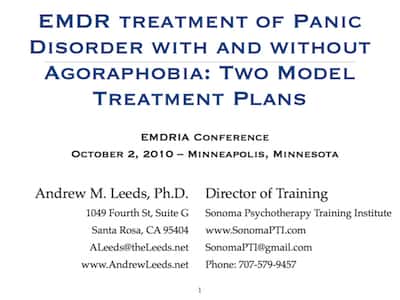
-
Summary
This presentation will review strengths and limitations of treatments for PD and PDA with a focus on cognitive and behavioral therapies, pharmacotherapy, and EMDR, and will present two EMDR treatment plans: a Model I plan for PD without agoraphobia or other co-occurring disorders; and a Model II plan for more complex cases of PDA or PD with co-occurring anxiety or Axis II disorders.
Clinical examples and specific guidelines will be presented for identifying PD targets and for when to extend preparation phase work and postpone reprocessing of core attachment material in Model II cases. -
Download
This free PDF provides the complete 2010 handout for session 333 of the EMDRIA Conference, presented October 2, 2010 in Minneapolis, MN by Andrew M. Leeds, PhD.
To download without cost just enter 0 in the price field. Or if you wish, put down any number from 1 or more.
AIP, Attachment Theory and EMDR Case Conceptualization

-
Summary
With complex cases many clinicians struggle with case formulation and predicting responses to EMDR reprocessing. This presentation integrates the Adaptive Information Processing Model with adult attachment classification.
Clinical case examples illustrate practical clinical strategies for assessing attachment classification as a foundation for case formulation. With conflicting models for treatment planning in the standard EMDR text, this presentation offers a symptom informed approach, incorporating elements of the parallel models of Korn (Korn, et al., 2004) and Leeds (2004).
Case example treatment plans will be presented in a visual format to illustrate how this model can be applied to simple and complex cases. -
Download
This PDF provides the complete 2009 handout for session 333 of the EMDRIA Conference, presented September 29, 2009, in Atlanta, GA by Andrew M. Leeds, Ph.D.
To download without cost just enter 0 in the price field. Or if you wish, put down any number from 1 or more.
How to Use Work Samples and Case Documentation in Remote EMDR Consultation

-
Summary
This presentation will present practical strategies for Approved Consultants (AC) and applicants for EMDRIA Certification (AEC) to use written work samples and case documentation to support remote EMDR consultation – via telephone or VOIP (Voice Over Internet Protocol) services.
By using written case summaries and near verbatim summaries of reprocessing sessions AC and consultees can achieve significant gains in understanding and fidelity in application of standard EMDR protocols and procedures.
Sample consultation agreements, written case materials and fidelity checklist will be provided to illustrate the use of written case summaries and near verbatim summaries of reprocessing sessions. -
Download
This free PDF provides the complete 2009 handout from of the 20th EMDRIA Conference, presented September 29, 2009 in Atlanta, GA by Andrew M. Leeds, PhD.
Many of the elements in this presentation were later incorporated into Chapters 16 and 17 of the 2009 and 2016 editions of A Guide to the Standard EMDR Therapy Protocols for Clinicians, Supervisors, and Consultants, 2nd Edition Springer Publishing Company. Comprehensive fidelity scales can be found in Appendix A of this book.
To download without cost just enter 0 in the price field. Or if you wish, put down any number from 1 or more.
Criteria for Assuring Appropriate Clinical Use and Avoiding Misuse of Resource Development & Installation When Treating Complex Posttraumatic Stress Syndromes
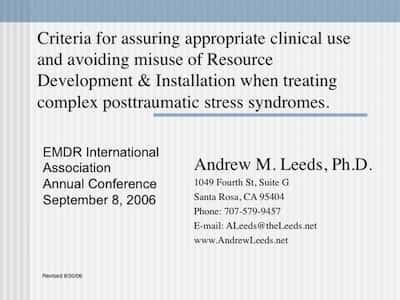
-
Summary
The consensus model of treatment for patients with complex posttraumatic syndromes emphasizes assuring adequate stabilization before and during uncovering and resolving of traumatic memories.
Resource Development and Installation (RDI) has been reported to be a potentially effective intervention for enhancing patient stabilization.
There are now several published descriptions and case reports of RDI including a summary in the standard reference text on EMDR.
The growing use of RDI by EMDR trained clinicians has been followed by reports indicating that a significant number of patients with posttraumatic stress syndromes who meet standard EMDR readiness criteria for ego strength and stability have been offered RDI without being offered standard EMDR reprocessing.
This presentation will review specific criteria for identifying: for which patients (1) and clinical situations (3) the use of RDI is indicated; for which patients and clinical situations (4) RDI should be offered cautiously, if at all, but alternate stabilization methods should be considered; and for which patients (2) RDI should not be offered but where standard EMDR reprocessing should be offered without delay.
An overview of RDI procedural steps will be presented (5) to clarify its use. Strategies will be offered to address technical, clinical and countertransference issues that may be associated with misuse of RDI. Clinical vignettes will be presented to illustrate appropriate clinical use, clinical cautions and misuse of RDI. -
Download
This free PDF provides the complete 2006 handout for session 226 of the EMDRIA Conference, presented September 8, 2006 in Philadelphia, PA by Andrew M. Leeds, PhD.
To download without cost just enter 0 in the price field. Or if you wish, put down any number from 1 or more.
Consultation for EMDRIA Certification: Challenges, Ethics, and Best Practices

-
Summary
These are the complete handouts from Session 235 at the 2019 EMDR International Association conference presented on September 13, 2019, in Anaheim.
-
Download
These two free PDFs provides the complete 2019 conference handout as a PDF - 3 slides per page as well as the reference list with additional resources.
These materials were prepared and presented by Andrew M. Leeds, PhD, Jennifer A. Madere, MA, and Christine Sells, PhD.
To download without cost just enter 0 in the price field. Or if you wish, put down any number from 1 or more.
How to Succeed as an EMDRIA Consultant in Training and Approved Consultant

-
Summary
These are the complete handouts from Session 114 at the 2022 EMDR International Association Virtual conference presented on September 11, 2022.
-
Download
These two free PDFs provides the complete 2022 conference handout as a PDF - 2 slides per page as well as the reference list with additional resources.
These materials were prepared and presented by Andrew M. Leeds, PhD, and Jennifer A. Madere, MA.
To download without cost just enter 0 in the price field. Or if you wish, put down any number from 1 or more.
An Update on the Progress and Future of EMDR Therapy - EMDRAA 2023 Invited Keynote

-
Summary
These are the complete handouts from the EMDR Association of Australia 2023 invited keynote on "An Update on the Progress and Future of EMDR Therapy" presented May 6, 2023.
The EMDR Association of Australia has made the video of this 2023 Keynote freely available at https://vimeo.com/830101565 -
Download
These two free PDFs provides the complete 2023 conference handout as a PDF - 2 slides per page as well as the reference list with additional resources.
These materials were prepared and presented by Andrew M. Leeds, PhD on May 6, 2023.
To download without cost just enter 0 in the price field. Or if you wish, put down any number from 1 or more.
Articles
Case Formulation: Strategies and Criteria for Selection of Negative and Positive Cognitions in EMDR

-
Summary
The process of selecting appropriate negative and positive cognitions can be a smoothly flowing preamble to an EMDR treatment session or it can be a complex search for an elusive quarry.
In this paper, I will review the principles and rationale underlying the selection of cognitions in EMDR and will consider procedures to guide us safely past common problems.
Most importantly, I will introduce the idea that the process of selecting cognitions can be greatly simplified and enriched when it is integrated into a case formulation approach. -
Download
This free PDF provides a complete version of the article “Case Formulation: Strategies and Criteria for Selection of Negative and Positive Cognitions In EMDR” that was adapted and updated from a handout presented by Andrew M. Leeds, Ph.D. at the 1994 EMDR Conference “Research and Clinical Applications” Sunnyvale, California.
The article contains numerous examples of challenges commonly encountered in the work of selecting NC and PC in Phase 3 — Assessment. These examples and commentary are drawn primarily from supervised training exercises.
To download without cost just enter 0 in the price field. Or if you wish, put down any number from 1 or more.
Developmental Pathways to Dissociation: Are We Forgetting Something?
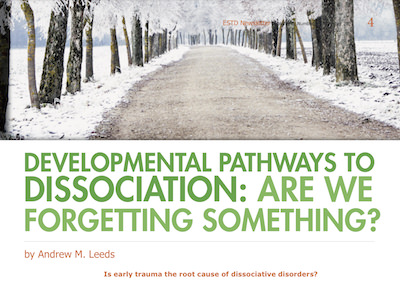
-
Summary
The article stirred some controversy within the editorial board at ESTD and led to the inclusion of “A Response To Andrew Leeds’ Article” by Orit Badouk Epstein, which is included in the PDF.
Leeds, A. M. (2012). Developmental pathways to dissociation: Are we forgetting something? ESTD Newsletter, 3(1), 4-9.
Leeds, A. M. (2012). Afterword to developmental pathways to dissociation. ESTD Newsletter, 3(1), 12. -
Introduction
Is early trauma the root cause of dissociative disorders?
Most of the literature and research on pathological forms of dissociation focuses on trauma as the root cause of the DSM IV-TR (American Psychiatric Association, 2000) dissociative disorders, and many studies show an association between dissociation and trauma (Putnam, 1997).
Yet this view is by no means universal as emerging research on attachment, evolutionary psychobiology, and the neurobiology of dissociation continues to influence the field. “The fact that nontraumatized individuals sometimes demonstrate dissociation and that not all trauma survivors dissociate suggests that there may be more to the etiology and development of dissociation than trauma alone” (Dutra, Bianchi, Siegel and Lyons-Ruth, 2009, p. 84).
If early trauma is not the unique cause of pathological dissociation, then what else could cause it? -
Download
This PDF provide the full text of this article published in the 2012 European Society for Trauma and Dissociation newsletter volume 3, number 1.
To download without cost just enter 0 in the price field. Or if you wish, put down any number from 1 or more.
Overcoming clinicians’ fear of using EMDR therapy: Practical Steps for Success
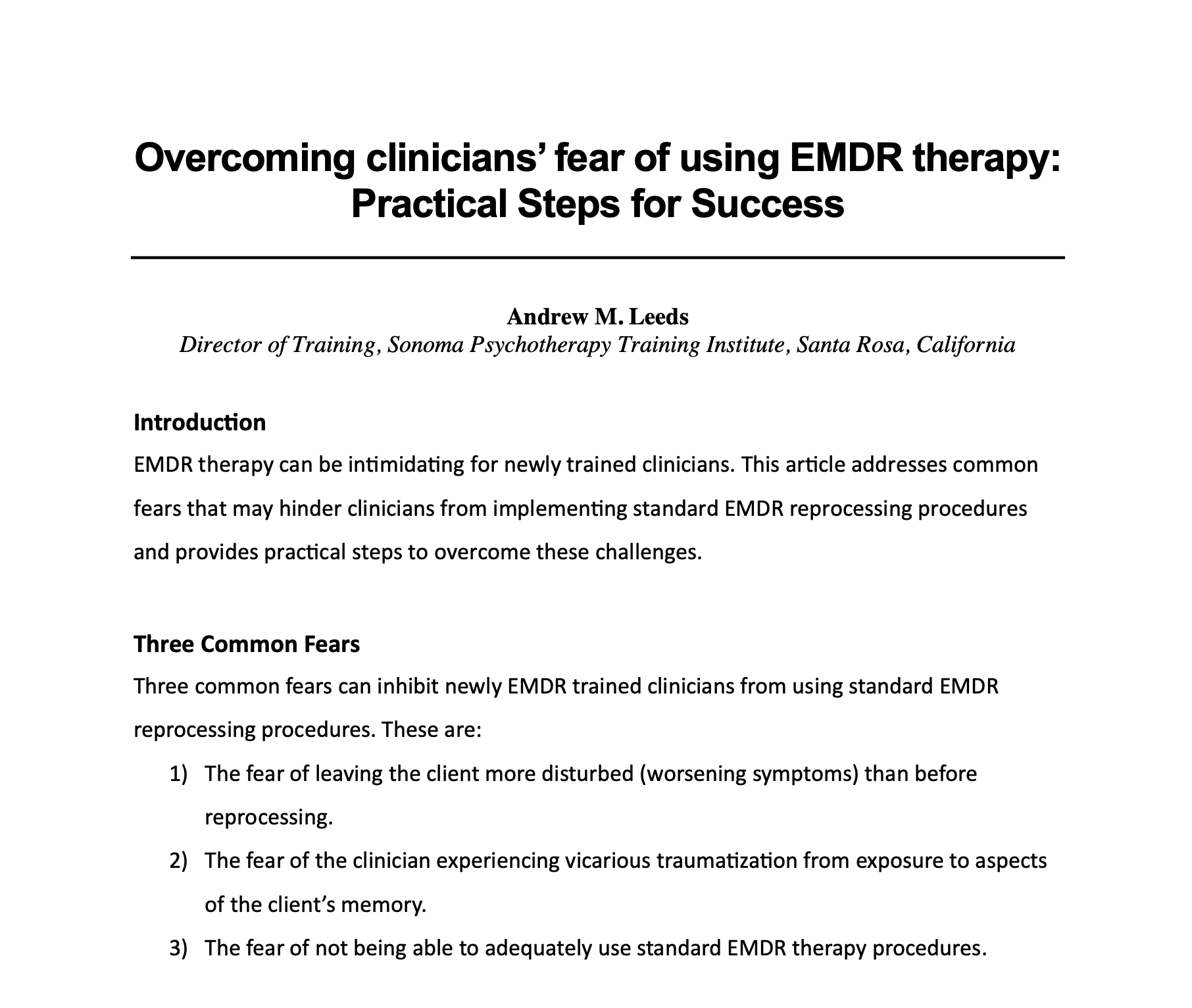
-
Summary
EMDR therapy can be intimidating for newly trained clinicians. This article addresses common fears that may hinder clinicians from implementing standard EMDR reprocessing procedures and provides practical steps to overcome these challenges.
-
Introduction
Three common fears can inhibit newly EMDR trained clinicians from using standard EMDR reprocessing procedures. These are:
1) The fear of leaving the client more disturbed (worsening symptoms) than before reprocessing.
2) The fear of the clinician experiencing vicarious traumatization from exposure to aspects of the client’s memory.
3) The fear of not being able to adequately use standard EMDR therapy procedures. -
Download
This PDF provides the original, complete six-page article with 16 references, most open-access journal articles.
To download without cost just enter 0 in the price field. Or if you wish, put down any number from 1 or more.
Resources
Resource Development and Installation Script From Andrew M. Leeds, Ph.D.

-
Summary
Korn, D. L., & Leeds, A. M. (2002). Preliminary evidence of efficacy for EMDR resource development and installation in the stabilization phase of treatment of complex posttraumatic stress disorder. Journal of Clinical Psychology, 58(12), 1465-1487.
This script is intended for use by clinicians who have taken an EMDRIA approved basic training EMDR therapy.
This script is an earlier version of the RDI scripts found in Exhibits B6 and B7 of the 2016 book A Guide to the Standard EMDR Therapy Protocols for Clinicians, Supervisors, and Consultants, 2nd Edition, Springer Publishing Company, New York.
Those wishing to reproduce or republish this script other than for their own individual use should seek permission from Springer Publishing Company, which holds the copyright to the most up-to-date version of this script. -
Download
This free download provides both a Microsoft Word document and a PDF version of the RDI script adapted from Korn & Leeds, 2002.
To download without cost just enter 0 in the price field. Or if you wish, put down any number from 1 or more.
EMDR Session Master
EMDR Therapy Case Inquiry Form
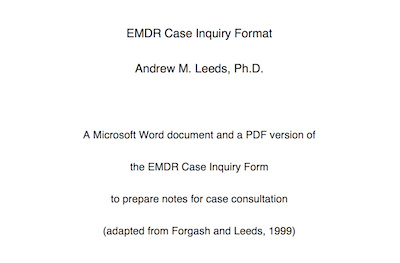
-
Summary
This is an earlier version of Exhibit B 14 found in the 2016 book A Guide to the Standard EMDR Therapy Protocols for Clinicians, Supervisors, and Consultants, 2nd Edition, Springer Publishing Company, New York.
-
Download
This free download provides a Microsoft Word document and a PDF version of the EMDR therapy Case Inquiry Form (adapted from Forgash and Leeds, 1999) that can be used to prepare notes for EMDR therapy case consultation.
To download without cost just enter 0 in the price field. Or if you wish, put down any number from 1 or more.
